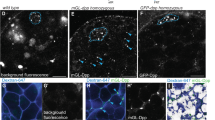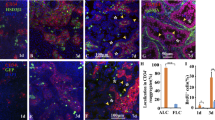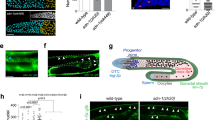Abstract
Interactions between stem cells and their surrounding microenvironment, or niche, are critical for the establishment and maintenance of stem-cell properties1. The adult Drosophila testis contains a morphologically discrete stem-cell niche, the 'hub'2,3,4. The small cluster of non-dividing, somatic hub cells at the anterior tip of the fly testis is contacted by the germline stem cells (GSCs)5, which retain their stem-cell character through the direct association with the hub6. Here we show that integrin-mediated adhesion is important for maintaining the correct position of embryonic hub cells during gonad morphogenesis. The misplaced hub in integrin-deficient embryos directs the orientation of cell divisions in the presumptive GSCs, a hallmark of the active germline stem-cell niche. A decrease in integrin-mediated adhesion in adult testes, which resulted in a loss of the hub and the stem-cell population, revealed the importance of hub-cell anchoring. Finally, we show that an extracellular matrix (ECM) is present around the gonad during late embryogenesis and that this ECM is defective in integrin-deficient gonads. On the basis of our data, we propose that integrins are required for the attachment of the hub cells to the ECM, which is essential for maintaining the stem-cell niche.
This is a preview of subscription content, access via your institution
Access options
Subscribe to this journal
Receive 12 print issues and online access
$209.00 per year
only $17.42 per issue
Buy this article
- Purchase on Springer Link
- Instant access to full article PDF
Prices may be subject to local taxes which are calculated during checkout





Similar content being viewed by others
References
Moore, K. A. & Lemischka, I. R. Stem cells and their niches. Science 311, 1880–1885 (2006).
Xie, T., Kawase, E., Kirilly, D. & Wong, M. D. Intimate relationships with their neighbors: tales of stem cells in Drosophila reproductive systems. Dev. Dyn. 232, 775–790 (2005).
Fuchs, E., Tumbar, T. & Guasch, G. Socializing with the neighbors: stem cells and their niche. Cell 116, 769–778 (2004).
Gilboa, L. & Lehmann, R. How different is Venus from Mars? The genetics of germ-line stem cells in Drosophila females and males. Development 131, 4895–4905 (2004).
Hardy, R. W., Tokuyasu, K. T., Lindsley, D. L. & Garavito, M. The germinal proliferation center in the testis of Drosophila melanogaster. J. Ultrastruct. Res. 69, 180–190 (1979).
Yamashita, Y. M., Jones, D. L. & Fuller, M. T. Orientation of asymmetric stem cell division by the APC tumor suppressor and centrosome. Science 301, 1547–1550 (2003).
Starz-Gaiano, M. & Lehmann, R. Moving towards the next generation. Mech. Dev. 105, 5–18 (2001).
Le Bras, S. & Van Doren, M. Development of the male germline stem cell niche in Drosophila. Dev. Biol. 294, 92–103 (2006).
Kittadate, Y., Shigenobu, S., Arita, K. & Kobayashi, S. Boss/Sev signaling from germline to soma restricts germline-stem-cell-niche formation in the anterior region of Drosophila male germline. Dev. Cell 13, 151–159 (2007).
Gonczy, P., Viswanathan, S. & DiNardo, S. Probing spermatogenesis in Drosophila with P-element enhancer detectors. Development 114, 89–98 (1992).
Danen, E. H. & Sonnenberg, A. Integrins in regulation of tissue development and function. J. Pathol. 201, 632–641 (2003).
Brown, N. H., Gregory, S. L. & Martin-Bermudo, M. D. Integrins as mediators of morphogenesis in Drosophila. Dev. Biol. 223, 1–16 (2000).
Hynes, R. O. Integrins: bidirectional, allosteric signaling machines. Cell 110, 673–687 (2002).
Brown, N. H. et al. Talin is essential for integrin function in Drosophila. Dev. Cell 3, 569–579 (2002).
Li, M. A., Alls, J. D., Avancini, R. M., Koo, K. & Godt, D. The large Maf factor Traffic Jam controls gonad morphogenesis in Drosophila. Nature Cell Biol. 5, 994–1000 (2003).
Devenport, D. & Brown, N. H. Morphogenesis in the absence of integrins: mutation of both Drosophila beta subunits prevents midgut migration. Development 131, 5405–5415 (2004).
Clark, K. A., McGrail, M. & Beckerle, M. C. Analysis of PINCH function in Drosophila demonstrates its requirement in integrin-dependent cellular processes. Development 130, 2611–2621 (2003).
Zervas, C. G., Gregory, S. L. & Brown, N. H. Drosophila integrin-linked kinase is required at sites of integrin adhesion to link the cytoskeleton to the plasma membrane. J. Cell Biol. 152, 1007–1018 (2001).
Deng, W. M. et al. Dystroglycan is required for polarizing the epithelial cells and the oocyte in Drosophila. Development 130, 173–184 (2003).
Steinberg, M. S. Reconstruction of tissues by dissociated cells. Some morphogenetic tissue movements and the sorting out of embryonic cells may have a common explanation. Science 141, 401–408 (1963).
Gumbiner, B. M. Regulation of cadherin-mediated adhesion in morphogenesis. Nature Rev. Mol. Cell Biol. 6, 622–634 (2005).
Godt, D. & Tepass, U. Drosophila oocyte localization is mediated by differential cadherin-based adhesion. Nature 395, 387–391 (1998).
Gonczy, P. & DiNardo, S. The germ line regulates somatic cyst cell proliferation and fate during Drosophila spermatogenesis. Development 122, 2437–2447 (1996).
Hayashi, S. et al. GETDB, a database compiling expression patterns and molecular locations of a collection of Gal4 enhancer traps. Genesis 34, 58–61 (2002).
Prakash, S., Caldwell, J. C., Eberl, D. F. & Clandinin, T. R. Drosophila N-cadherin mediates an attractive interaction between photoreceptor axons and their targets. Nature Neurosci. 8, 443–450 (2005).
Dietzl, G. et al. A genome-wide transgenic RNAi library for conditional gene inactivation in Drosophila. Nature 448, 151–156 (2007).
Chou, T. B. & Perrimon, N. The autosomal FLP-DFS technique for generating germline mosaics in Drosophila melanogaster. Genetics 144, 1673–1679 (1996).
Brower, D. L., Wilcox, M., Piovant, M., Smith, R. J. & Reger, L. A. Related cell-surface antigens expressed with positional specificity in Drosophila imaginal discs. Proc. Natl Acad. Sci. USA 81, 7485–7489 (1984).
Bogaert, T., Brown, N. & Wilcox, M. The Drosophila PS2 antigen is an invertebrate integrin that, like the fibronectin receptor, becomes localized to muscle attachments. Cell 51, 929–940 (1987).
Acknowledgements
We thank S. Baumgartner, L. Cooley, R. Lehmann, J. Raff, R. Basto and the Developmental Studies Hybridoma Bank (University of Iowa, IA) for antibodies; B. Dickson and F. Schnorrer for RNAi fly stocks, the Drosophila Genomics Resource Center (Kyoto Institute of Technology) for the tj-GAL4 line; T. Clandinin (Stanford University, Palo Alto, CA) and U. Tepass for cadherin fly stocks; and S. Choksi, L. Jones (UCSD, San Diego, CA) and U. Tepass for critical reading of the manuscript. This work was supported by a Natural Sciences and Engineering Research Council of Canada grant to D.G., Wellcome Trust grants to N.H.B. (69943) and D.D. (72817), a Human Frontiers Science Program Long Term Fellowship and a Development Travelling Fellowship to G.T.
Author information
Authors and Affiliations
Corresponding author
Ethics declarations
Competing interests
The authors declare no competing financial interests.
Supplementary information
Supplementary Information
Supplementary figures S1, S2, S3, S4 and S5 (PDF 1241 kb)
Rights and permissions
About this article
Cite this article
Tanentzapf, G., Devenport, D., Godt, D. et al. Integrin-dependent anchoring of a stem-cell niche. Nat Cell Biol 9, 1413–1418 (2007). https://doi.org/10.1038/ncb1660
Received:
Accepted:
Published:
Issue Date:
DOI: https://doi.org/10.1038/ncb1660
This article is cited by
-
Ihog proteins contribute to integrin-mediated focal adhesions
Science China Life Sciences (2023)
-
Knockout of integrin β1 in induced pluripotent stem cells accelerates skin-wound healing by promoting cell migration in extracellular matrix
Stem Cell Research & Therapy (2022)
-
A coarse-grained approach to model the dynamics of the actomyosin cortex
BMC Biology (2022)
-
A dual role of lola in Drosophila ovary development: regulating stem cell niche establishment and repressing apoptosis
Cell Death & Disease (2022)
-
Special vulnerability of somatic niche cells to transposable element activation in Drosophila larval ovaries
Scientific Reports (2020)



